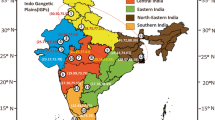Abstract
The time series of ozone columns measured with the SBUV satellite instrument over three subarctic stations (Saint Petersburg, Harestua, and Kiruna) are analyzed. The daily and monthly mean ozone values in the layers of 0–25, 25–60, and 0–60 km are compared with the results of simulations with RSHU and EMAC numerical models for the period of 2000–2015. Model data are in good agreement with satellite data both in general and in the cases of rapid short-term ozone loss. However, there are some differences between the models and measurements as well as between the two considered models. These differences require the more detailed analysis in order to modify model parameters. Experimental data demonstrate the increase in ozone columns in the layer of 25–60 km which amounts to 2.1 ± 0.7, 2.4 ± 0.7, and 1.5 ± 0.8% per decade for Saint Petersburg, Harestua, and Kiruna stations, respectively. The results of numerical simulations do not contradict these estimates.
Similar content being viewed by others
References
Ya. A. Virolainen, Yu. M. Timofeev, A. V. Polyakov, et al., “Comparing Data Obtained from Ground-based Measurements of the Total Contents of O3, HNO3, HCl, and NO2 and from Their Numerical Simulation,” Izv. Akad. Nauk, Fiz. Atmos. Okeana, No. 1, 52 (2016) [Izv., Atmos. Oceanic Phys., No. 1, 52 (2016)].
A. M. Zvyagintsev, N. S. Ivanova, M. P. Nikiforova, et al., “Ozone Content over the Russian Federation in the First Quarter of 2016,” Meteorol. Gidrol., No. 5 (2016) [Russ. Meteorol. Hydrol., No. 5, 41 (2016)].
M. P. Nikiforova, P. N. Vargin, A. M. Zvyagintsev, et al., “Ozone Mini-hole over the North of the Urals and Siberia,” Trudy Gidromettsentra Rossii, No. 360 (2016) [in Russian].
S. P. Smyshlyaev, Ya. A. Virolainen, M. A. Motsakov, et al., “Interannual and Seasonal Variations in Ozone in Different Atmospheric Layers over Saint Petersburg Based on Observational Data and Numerical Modeling,” Izv. Akad. Nauk, Fiz. Atmos. Okeana, No. 3, 53 (2017) [Izv., Atmos. Oceanic Phys., No. 3, 53 (2017)].
P. K. Bhartia, R. D. McPeters, L. E. Flynn, et al., “Solar Backscatter UV (SBUV) Total Ozone and Profile Algorithm,” Atmos. Meas. Tech., 6 (2013).
D. P. Dee, S. M. Uppala, A. J. Simmons, et al., “The ERA-Interim Reanalysis: Configuration and Performance of the Data Assimilation System,” Quart. J. Roy. Meteorol. Soc., 137 (2011).
T. Egorova, E. Rozanov, V. Zubov, et al., “Chemistry-climate Model SOCOL: A Validation of the Present-day Climatology,” Atmos. Chem. Phys., 5 (2005).
V. Eyring, N. Butchart, D. W. Waugh, et al., “Assessment of Temperature, Trace Species, and Ozone in Chemistry Climate Model Simulations of the Recent Past,” J. Geophys. Res., 111 (2006).
P. Jockel, H. Tost, A. Pozzer, et al., “The Atmospheric Chemistry General Circulation Model ECHAM5/MESSy1: Consistent Simulation of Ozone from the Surface to the Mesosphere,” Atmos. Chem. Phys., 6 (2006).
D. Pendlebury, D. Plummer, J. Scinocca, et al., “Comparison of the CMAM30 Data Set with ACE-FTS and OSIRIS: Polar Regions,” Atmos. Chem. Phys., 15 (2015).
M. M. Rienecker, M. J. Suarez, R. Gelaro, et al., “MERRA: NASA's Modern-Era Retrospective Analysis for Research and Applications,” J. Climate, 24 (2011).
M. Righi, V. Eyring, K.-D. Gottschaldt, et al., “Quantitative Evaluation of Ozone and Selected Climate Parameters in a Set of EMAC Simulations,” Geosci. Model Dev., 8 (2015).
Y. Timofeev, Y. Virolainen, M. Makarova, et al., “Ground-based Spectroscopic Measurements of Atmospheric Gas Composition near Saint Petersburg (Russia),” J. Mol. Spectr., 323 (2016).
C. Vigouroux, T. Blumenstock, M. Coffey, et al., “Trends of Ozone Total Columns and Vertical Distribution from FTIR Observations at Eight NDACC Stations around the Globe,” Atmos. Chem. Phys., 15 (2015).
W. M. F. Wauben, J. P. F. Fortuin, P. F. J. van Velthoven, and H. M. Kelder, “Comparison of Modeled Ozone Distributions with Sonde and Satellite Observations,” J. Geophys. Res., No. D3, 103 (1998).
WMO. Scientific Assessment of Ozone Depletion: 2006. Global Ozone Research and Monitoring Project, Report No. 50 (WMO, Geneva, 2007).
Author information
Authors and Affiliations
Corresponding author
Additional information
Original Russian Text © Ya.A. Virolainen, Yu.M. Timofeev, I.A. Berezin, S.P. Smyshlyaev, M.A. Motsakov, O. Kirner, 2018, published in Meteorologiya i Gidrologiya, 2018, No. 3, pp. 40–47.
About this article
Cite this article
Virolainen, Y.A., Timofeev, Y.M., Berezin, I.A. et al. Validation of Atmospheric Numerical Models Based on Satellite Measurements of Ozone Columns. Russ. Meteorol. Hydrol. 43, 161–167 (2018). https://doi.org/10.3103/S1068373918030044
Received:
Accepted:
Published:
Issue Date:
DOI: https://doi.org/10.3103/S1068373918030044




